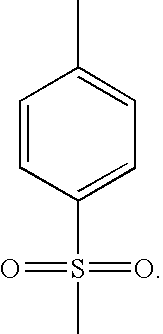Pigment dispersant
a pigment dispersant and radical polymerization technology, applied in the field of pigment dispersants, can solve the problems of non-living or free, radical polymerization methods to synthesize pigment dispersants, and little control over molecular weight, molecular weight distribution, and polymer chain structure,
- Summary
- Abstract
- Description
- Claims
- Application Information
AI Technical Summary
Benefits of technology
Problems solved by technology
Method used
Image
Examples
synthesis example a
[0042]This example describes the preparation of an acrylic dispersant, which is subsequently used to form the following pigment dispersions. The acrylic dispersant was prepared from the mixture of the following ingredients in the ratios indicated in Table A:
[0043]
TABLE AIngredientsWeight (grams)Charge In-Butyl Acetate1854.802,2″-Bipyridyl17.18Copper (0) Powder6.99Glycidyl Methacrylate703.89Para-Toluenesulfonyl Chloride104.5Charge IIN-Butyl Methacrylate739.08Hydroxypropyl Methacrylate1034.21n-Butyl Acetate1854.80Charge IIIn-Butyl Acrylate683.79Charge IVAcetic Acid65.79Ion Exchange Resin*419.95Charge V3-Hydroxy-2-Napthoic Acid526.71*(AMBERLITE IRC-748I) commercially available from ALFA AESAR.
[0044]Charge I was mixed in a 12 liter round-bottomed flask fitted with an air motor stirrer, a thermocouple, nitrogen adapter, and a condenser. The mixture was then sparged with nitrogen for 15 minutes. After the sparge the reaction solution was heated under a nitrogen blanket to 70° C. and held ...
example 1
[0045]Pigment Yellow 138 (PY 138) was milled and dispersed in the mill base formula shown in Table 1, on a QM-1 QMAX Supermill (Premier Mill, SPX Process Equipment) using 0.3 mm YTZ milling media to the final % haze value shown in Table 2.
example 2
[0046]Pigment Yellow 139 (PY 139) was milled and dispersed in the mill base formula shown in Table 1, on a QM-1 QMAX Supermill (Premier Mill, SPX Process Equipment) using 0.3 mm YTZ milling media to the final % haze value shown in Table 2.
PUM
| Property | Measurement | Unit |
|---|---|---|
| average primary particle size | aaaaa | aaaaa |
| haze | aaaaa | aaaaa |
| particle size | aaaaa | aaaaa |
Abstract
Description
Claims
Application Information
 Login to View More
Login to View More - R&D
- Intellectual Property
- Life Sciences
- Materials
- Tech Scout
- Unparalleled Data Quality
- Higher Quality Content
- 60% Fewer Hallucinations
Browse by: Latest US Patents, China's latest patents, Technical Efficacy Thesaurus, Application Domain, Technology Topic, Popular Technical Reports.
© 2025 PatSnap. All rights reserved.Legal|Privacy policy|Modern Slavery Act Transparency Statement|Sitemap|About US| Contact US: help@patsnap.com

